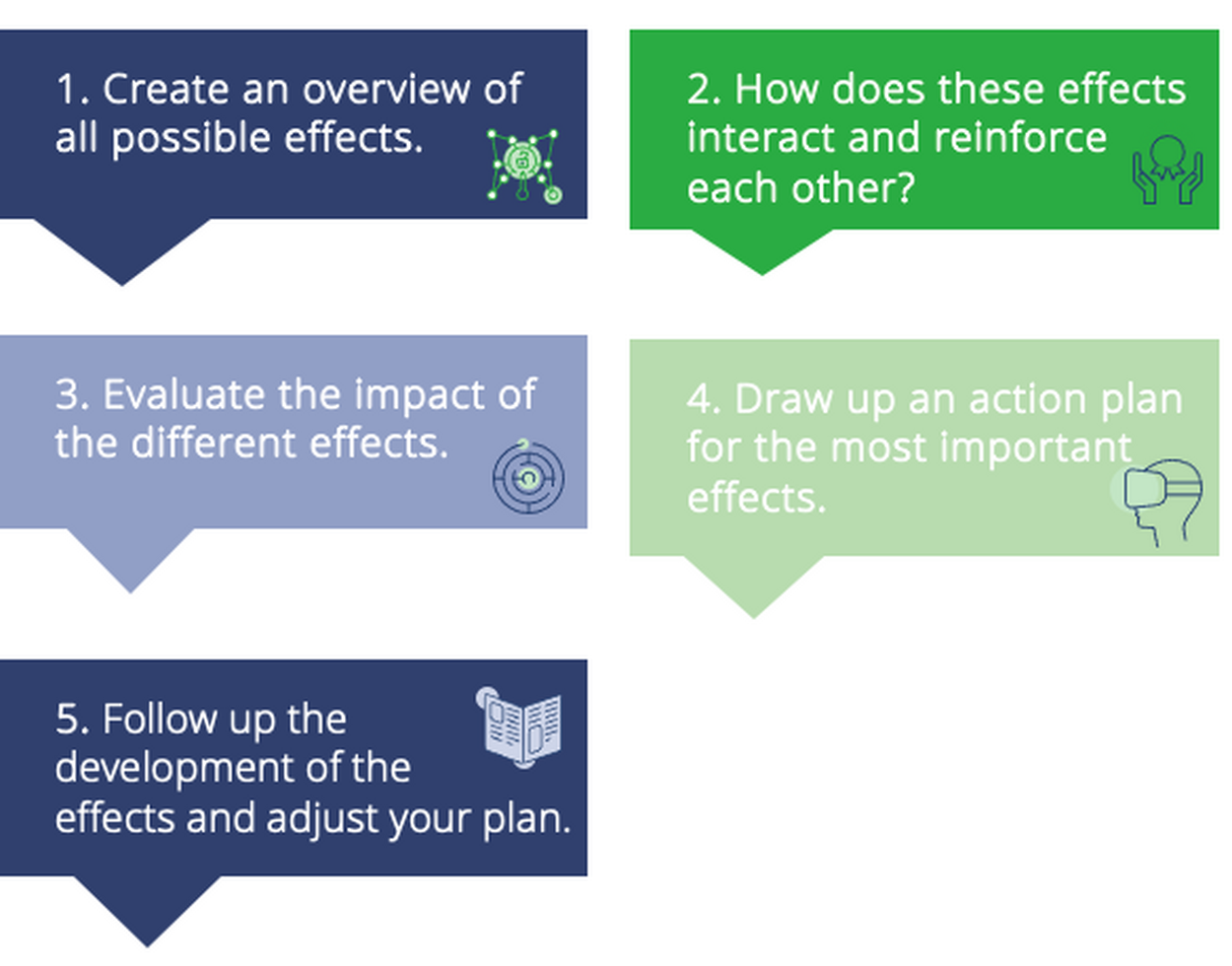How do you decide on the right direction for 2021 if everything can be different tomorrow? Does it make sense to plan when everything is uncertain? Not knowing what tomorrow will bring creates unrest and can even paralyze some organizations. Navigating and setting a course for your organization is more challenging than ever before.
In troubled waters, looking to the future is more essential than ever. A first step to detach your organization from the uncomfortable feeling of uncertainty is to gain a good insight into how these uncertain developments can “possibly” impact your organization and the ecosystem in which you operate. Looking at the broad horizon, you can anticipate better, make your plans more agile and get everyone on the same page.
How do you get started?
To illustrate this step-by-step plan, we use the COVID impact analysis on spatial development that we made on behalf of the Province of Limburg. *
1. Create an overview of all possible relevant effects of the development, in this case Covid-19. Put together a diverse team of employees and start from a broad perspective.
Do not limit yourself to those effects that are purely relevant to your organization but start from the sector/ecosystem in which you operate. Consider effects in different domains. We use the PESTLE approach for this, taking into account political, economic, socio-cultural, technological, legal and environmental effects.
From the case of the province of Limburg:
On a socio-cultural level we see, among other things, an exponential growth in home working, an increasing need for relaxation in the own neighborhood, the impact on mental well-being within the family,… Economically, e-commerce boomed, but domestic tourism (staycations) also gained importance. On the other hand, unemployment rose and we are probably facing a wave of bankruptcies. On a technological level, investments in digital technology such as e-health, e-education,… are getting a huge boost.
Have an eye for potential effects on both the micro (local) and macro (global) level. We tend to look at the effects in our immediate environment, but effects on a global level may also get closer in the long term.
From the case of the province of Limburg:
The uncertainty in global supply chains and the dependence on foreign production companies can initiate an accelerated development towards decentralization/re-shoring. On the other hand, the importance of short-chain initiatives has been growing at a local level.
Take both the short and the long-term perspective. Some effects are still uncertain and may have a stronger effect in the long term. If necessary, estimate the period during which it can have an effect.
From the case of the province of Limburg:
The increased investment that local authorities have to make today to contain the Covid crisis can have an effect on investments in, for example, infrastructure projects in the long term.
2. We must be aware that these effects do not take place in isolation and mutually influence or amplify each other. How do the effects influence each other? Each effect also has potential secondary (consequence) effects, the so-called second order implications. Some effects have a direct influence, others can have a stronger impact on your organization or sector on second instance.
From the case of the province of Limburg:
The growth in working from home requires more space at home and in the garden. The functional needs of our houses will evolve. The need for relaxation in the neighborhood will reinforce the importance of nature and the accessibility of greenery. Unemployment can lead to declining purchasing power and jeopardize the affordability of housing. E-commerce increases the pressure on the logistics system and physical stores. Which could accelerate the trend in vacancy.
3. Evaluate the potential impact of each of the effects on your organization or your sector. If necessary, validate the development of these effects via an expert panel.
From the case of the province of Limburg:
From a long list of 70+ effects, 10 effects were selected that could potentially have a major impact on spatial development in Limburg. These effects were not entirely new but have been extra exposed by Covid and require accelerated adapted action. The effects were formulated as 10 challenges on which people want to work together as a priority at the level of citizens, businesses and neighborhoods.
“WHEN EVERYTHING IS UNSURE, ANYTHING IS POSSIBLE!”
4. Draw up an action plan for the effects with a potentially major impact on your organization or sector.
From the case of the province of Limburg:
The 10 challenges were answered with 10 specific recommendations. We made sure that the measures taken in the context of corona can coincide with the long-term objectives regarding spatial planning. Corona offers an opportunity to accelerate the realization of the proposed policy.
5. Follow up the development of the effects on a regular basis and adjust your action plan. Create an active monitor for change, not only for the Covid effects, but also for other future developments. Form a “future team” that keeps this future radar active. Read more about how to set up an early warning system for your organization.
This approach enables you to make the complexity and uncertainty of certain developments more comprehensible. A clearer and broader perspective on the matter is obtained. It offers you the opportunity to set up a structured dialogue within your teams and to follow up the development further with the right focus.

How can Tomorrowlab support you?
In these future-oriented impact analyzes, we at TomorrowLab take on the role of researchers, process facilitators and challengers. Our innovation designers explore the potential effects from a broad perspective. From our cross-sectoral knowledge and network, we interlink developments in various domains and we pay attention to systemic connections and second-order implications. It is one of our tools to shape a more dynamic future strategy for your organization and to define concrete innovation projects.
For the province of Limburg, this research resulted in a concrete impact report with an agile action plan and room for inspiration and best practices. View the report “Plans after Corona” to get a concrete picture of the approach and options.
Read more about ourforesight techniques such as scenario planning to take into account a multitude of developments in the long term and to increase the agility of your organization.
* Starting from the potential effects of Covid-19 on spatial development, Deputy Inge Moors wished to share concrete recommendations and inspiring best practices with local authorities, spatial planners, project developers and architects.

